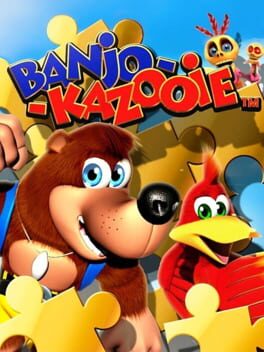Of all the games in Rare’s expansive catalog, Banjo-Kazooie best encapsulates the studio’s storied history. A quirky 3D platformer that represents Rare at the peak of the creative prowess, it was released on the Nintendo 64 at a time when the console was already flagging against Sony’s CD-powered juggernaut. The circumstances of its release, and Rare’s subsequent shift from working exclusively with Nintendo to joining Microsoft, have led the bear and bird to becoming a forgotten duo.
In any case, the creativity here is undeniable. Banjo-Kazooie feels like an indie developer’s fever-dream Unity platformer that was given enough support to blossom into a full-blown, high-quality game. Banjo and Kazooie are as zany as heroes come, and the supporting cast is even zanier. Who thought to pit the player against a crotchety green witch who always speaks in rhyme? And how about the “Game Over” cutscene, which in 2023 wouldn’t get off the drawing board, much less into the final source code? Green-skinned Barbie is so 1998.
Every room is different from the last, and the game always kept me in the dark about what was coming next. But when every level is an experiment, there are bound to be a few flops, and in Banjo-Kazooie the questionable design decisions disproportionately weigh down the back half. Rusty Bucket Bay and Click Clock Wood have finicky platforming bits, with long walks of shame when you inevitably fall and need to try again. Then there’s Grunty’s Furnace Fun, the final stage, whose name that’s only two-thirds true. It feels like a throwback to NES-era game design, with the bonus addition of guide-proof trivia questions thrown in just for kicks. I didn’t much enjoy it, though I admit I felt a small sense of satisfaction upon passing it and then laying the smackdown on the final boss.
While these sections are annoying in a modern context, one in which I have thousands of games to play and not enough time to play them, I suspect if I went back in time to 1998 I’d feel differently. Nintendo 64 game carts were expensive, and for a kid with just a couple of them, Banjo-Kazooie’s level of difficulty would’ve been a godsend, providing extra hours of fun. Although many players gave up before reaching the true ending, the good vibes they felt while dashing, jumping, and flying around the game’s lovingly crafted levels were crystalized in their memories for decades to come.
As I write this review, it’s already been over a week since I finished Banjo-Kazooie. Yet even now, with my playthrough not even a month behind me, I can already feel my recollections of the game growing fonder. Frustration fades away and only fond impressions of pure creative exuberance remain. Perhaps this explains why everyone thought Yooka-Laylee was a good idea until they didn’t.
In any case, the creativity here is undeniable. Banjo-Kazooie feels like an indie developer’s fever-dream Unity platformer that was given enough support to blossom into a full-blown, high-quality game. Banjo and Kazooie are as zany as heroes come, and the supporting cast is even zanier. Who thought to pit the player against a crotchety green witch who always speaks in rhyme? And how about the “Game Over” cutscene, which in 2023 wouldn’t get off the drawing board, much less into the final source code? Green-skinned Barbie is so 1998.
Every room is different from the last, and the game always kept me in the dark about what was coming next. But when every level is an experiment, there are bound to be a few flops, and in Banjo-Kazooie the questionable design decisions disproportionately weigh down the back half. Rusty Bucket Bay and Click Clock Wood have finicky platforming bits, with long walks of shame when you inevitably fall and need to try again. Then there’s Grunty’s Furnace Fun, the final stage, whose name that’s only two-thirds true. It feels like a throwback to NES-era game design, with the bonus addition of guide-proof trivia questions thrown in just for kicks. I didn’t much enjoy it, though I admit I felt a small sense of satisfaction upon passing it and then laying the smackdown on the final boss.
While these sections are annoying in a modern context, one in which I have thousands of games to play and not enough time to play them, I suspect if I went back in time to 1998 I’d feel differently. Nintendo 64 game carts were expensive, and for a kid with just a couple of them, Banjo-Kazooie’s level of difficulty would’ve been a godsend, providing extra hours of fun. Although many players gave up before reaching the true ending, the good vibes they felt while dashing, jumping, and flying around the game’s lovingly crafted levels were crystalized in their memories for decades to come.
As I write this review, it’s already been over a week since I finished Banjo-Kazooie. Yet even now, with my playthrough not even a month behind me, I can already feel my recollections of the game growing fonder. Frustration fades away and only fond impressions of pure creative exuberance remain. Perhaps this explains why everyone thought Yooka-Laylee was a good idea until they didn’t.
Reviewed on Apr 20, 2023
